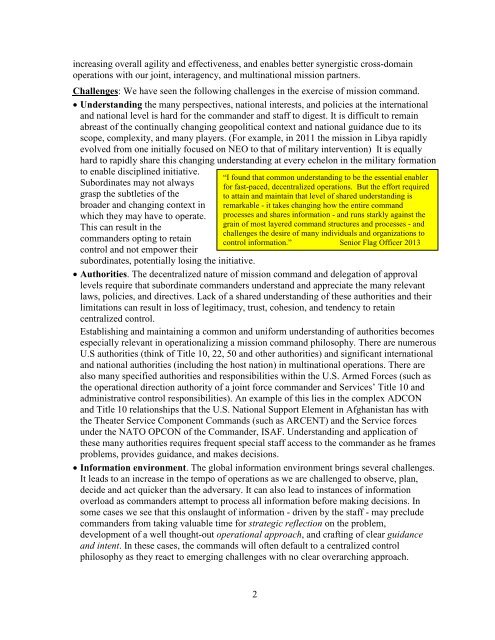Mission Command and Cross-Domain Synergy - Defense ...
Mission Command and Cross-Domain Synergy - Defense ...
Mission Command and Cross-Domain Synergy - Defense ...
- No tags were found...
Create successful ePaper yourself
Turn your PDF publications into a flip-book with our unique Google optimized e-Paper software.
increasing overall agility <strong>and</strong> effectiveness, <strong>and</strong> enables better synergistic cross-domainoperations with our joint, interagency, <strong>and</strong> multinational mission partners.Challenges: We have seen the following challenges in the exercise of mission comm<strong>and</strong>.• Underst<strong>and</strong>ing the many perspectives, national interests, <strong>and</strong> policies at the international<strong>and</strong> national level is hard for the comm<strong>and</strong>er <strong>and</strong> staff to digest. It is difficult to remainabreast of the continually changing geopolitical context <strong>and</strong> national guidance due to itsscope, complexity, <strong>and</strong> many players. (For example, in 2011 the mission in Libya rapidlyevolved from one initially focused on NEO to that of military intervention) It is equallyhard to rapidly share this changing underst<strong>and</strong>ing at every echelon in the military formationto enable disciplined initiative.Subordinates may not alwaysgrasp the subtleties of thebroader <strong>and</strong> changing context inwhich they may have to operate.This can result in thecomm<strong>and</strong>ers opting to retaincontrol <strong>and</strong> not empower theirsubordinates, potentially losing the initiative.“I found that common underst<strong>and</strong>ing to be the essential enablerfor fast-paced, decentralized operations. But the effort requiredto attain <strong>and</strong> maintain that level of shared underst<strong>and</strong>ing isremarkable - it takes changing how the entire comm<strong>and</strong>processes <strong>and</strong> shares information - <strong>and</strong> runs starkly against thegrain of most layered comm<strong>and</strong> structures <strong>and</strong> processes - <strong>and</strong>challenges the desire of many individuals <strong>and</strong> organizations tocontrol information.” Senior Flag Officer 2013• Authorities. The decentralized nature of mission comm<strong>and</strong> <strong>and</strong> delegation of approvallevels require that subordinate comm<strong>and</strong>ers underst<strong>and</strong> <strong>and</strong> appreciate the many relevantlaws, policies, <strong>and</strong> directives. Lack of a shared underst<strong>and</strong>ing of these authorities <strong>and</strong> theirlimitations can result in loss of legitimacy, trust, cohesion, <strong>and</strong> tendency to retaincentralized control.Establishing <strong>and</strong> maintaining a common <strong>and</strong> uniform underst<strong>and</strong>ing of authorities becomesespecially relevant in operationalizing a mission comm<strong>and</strong> philosophy. There are numerousU.S authorities (think of Title 10, 22, 50 <strong>and</strong> other authorities) <strong>and</strong> significant international<strong>and</strong> national authorities (including the host nation) in multinational operations. There arealso many specified authorities <strong>and</strong> responsibilities within the U.S. Armed Forces (such asthe operational direction authority of a joint force comm<strong>and</strong>er <strong>and</strong> Services’ Title 10 <strong>and</strong>administrative control responsibilities). An example of this lies in the complex ADCON<strong>and</strong> Title 10 relationships that the U.S. National Support Element in Afghanistan has withthe Theater Service Component <strong>Comm<strong>and</strong></strong>s (such as ARCENT) <strong>and</strong> the Service forcesunder the NATO OPCON of the <strong>Comm<strong>and</strong></strong>er, ISAF. Underst<strong>and</strong>ing <strong>and</strong> application ofthese many authorities requires frequent special staff access to the comm<strong>and</strong>er as he framesproblems, provides guidance, <strong>and</strong> makes decisions.• Information environment. The global information environment brings several challenges.It leads to an increase in the tempo of operations as we are challenged to observe, plan,decide <strong>and</strong> act quicker than the adversary. It can also lead to instances of informationoverload as comm<strong>and</strong>ers attempt to process all information before making decisions. Insome cases we see that this onslaught of information - driven by the staff - may precludecomm<strong>and</strong>ers from taking valuable time for strategic reflection on the problem,development of a well thought-out operational approach, <strong>and</strong> crafting of clear guidance<strong>and</strong> intent. In these cases, the comm<strong>and</strong>s will often default to a centralized controlphilosophy as they react to emerging challenges with no clear overarching approach.2
















